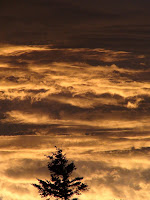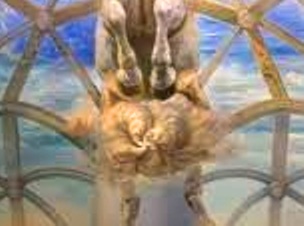Dear William,
It is an extremely interest to compare the translations of one poem in the Poems of the Little Flower of Jesus.
There is also the multi-task in melodies, chords, keys in the features of the FACE in our vision.
There are countless pictures of Jesus in devotion pictures.
I love to 'read' the Holy Face in the trees in our windows.
Looking the trees in the wind and see the faces. ...
There is more to remember from St Theres's being named 'of the Holy Face'.
Beyond all the FACES, the divine presence, is faith in God who IS!

For the moment pondering.
God love.
fr. Donald
Poems of the Little Flower of Jesus
CANTICLE TO THE HOLY FACE
COMMENTARY:
'Begemmed' re the tears of the Holy Face in the Poem of Therese paused for thought, a rather unfamiliar word.
The Canticle to the Holy Face is another curtain raiser to the whole 'story of the soul', of Saint Therese of the Infant of Jesus and of the Holy Face.
Writing, poetry, art, dance, song, is the multi-task of her life in fullness.
One tip of iceberg from the translation, "Holy Face) Of those dear Eyes begemmed with tears", "De tes yeux embellis de
pleurs", immerses to the Face visions.
Icons, paintings and Biblical references to the Divine Face echoes in Therese of the Holy Face.
The chart of the 4 versions of the poem give lessons well.
Surprising is to find the Internet translation from the original being very literal and seems to prove the best poem.
Reading and re-reading the French and Internet translation gives me unending grasp of mind and heart.
Reading and re-reading the French and Internet translation gives me unending grasp of mind and heart.
http://www.abbaye-saint-benoit.ch/saints/carmel/thereseenfj/poesies1/025.htm
2. Collected Poems of Therese of Lisieux. Translated by Alan Bancroft.
3. Poems of St Therese of the Child Jesus. Translated by the Carmelites of Santa Clara, Cal., USA. Oct 1925
Cantique à la
Sainte Face.
Original: French
Jésus ton ineffable image
Est l'astre qui conduit
mes pas ;
Tu le sais bien, ton doux
Visage
Est pour moi le ciel
ici-bas !
Mon amour découvre les
charmes
De tes yeux embellis de
pleurs.
Je souris à travers mes
larmes,
Quand je contemple tes
douleurs.
Oh ! je veux pour te
consoler
Vivre ignorée et
solitaire;
Ta beauté que tu sais
voiler
Me découvre tout son
mystère,
Et vers toi je voudrais
voler!
Ta Face est ma seule
patrie,
Elle est mon royaume
d'amour;
Elle est ma riante
prairie,
Mon doux soleil de chaque
jour;
Elle est le lis de la
vallée
Dont le parfum mystérieux
Console mon âme exilée,
Lui fait goûter la paix
des cieux.
Elle est mon repos, ma
douceur,
Et ma mélodieuse lyre...
Ton Visage, ô mon doux
Sauveur,
Est le divin bouquet de
myrrhe
Que je veux garder sur
mon coeur !
Ta Face est ma seule
richesse;
Je ne demande rien de
plus.
En elle, me cachant sans
cesse,
Je te ressemblerai, Jésus
!
Laisse en moi la divine
empreinte
De tes traits remplis de
douceurs,
Et bientôt je deviendrai
sainte,
Vers toi j'attirerai les
coeurs !
Afin que je puisse
amasser
Une belle moisson dorée,
De tes feux daigne
m'embraser!
Bientôt, de ta bouche
adorée,
Donne-moi l’éternel
baiser!
12 août 1895.
1
Certains airs profanes, comme celui-ci, avaient été indiqués à la
Bienheureuse par sa cousine, Sr Marie de l'Eucharistie, et elle s'était
inspirée du rythme pour composer ses vers.
Depuis,
bien des auteurs se sont essayés à mettre en musique quelques-unes de ces
poésies. Un recueil en a été édité.
|
Hymn to the Holy Face.
Translation: Internet
Jesus your ineffable picture
Is the star that guided my
steps;
You know it, your sweet face
Is my heaven on earth!
My love discovers the charms
Your eyes embellished with
tears.
I smiled through my tears,
When I look at your pain.
Oh! I want to comfort you
Living ignored and lonely;
You know your beauty veil
I discovered all its mystery,
And I want you to fly!
Your Face is my only home,
She is my kingdom of love;
It is my cheerful meadow,
My sweet sun each day;
She is the lily of the valley
Whose mysterious perfume
Console my exiled soul,
A taste of heaven him peace.
It is my rest, my sweetness,
And my melodious lyre ...
Your face, my sweet Savior,
Is the divine bouquet of myrrh
I want to keep on my heart!
Your Face is my only wealth;
I ask nothing more.
In it, hiding me constantly,
I'll look like you, Jesus!
Let me in the divine imprint
Of your lines filled with
sweets,
And soon I will become holy,
To you I will draw the hearts!
So I can raise
A golden harvest
Of your fires ablaze deigns me
Soon, your mouth adored
Give me the eternal kiss!
August 12, 1895.
1 Some secular tunes, as it had
been given to the Blessed by his cousin, Sister Mary of the Eucharist, and
she was inspired to compose his pace.
Since then, many authors have
tried to put some music of these poems. A
collection has been published.
|
CANTICLE TO THE HOLY FACE
Translated by the Carmelites of Santa Clara, Cal., USA. Oct 1925
JESUS, Thine image, fair to trace,
Shall be my star, where'er I go,
Thou knowest, in Thy Sacred Face,
I find my Heaven, while here below.
My love hath found the charm untold
Of those dear Eyes begemmed with tears,
I smile, though weeping, to behold
The grief that in their depth appears.
Fain would I, to be Thy solace,
Live forgotten and unknown,
For the beauty Thou art veiling
Hath to me its secret shown, Drawing me to Thee alone.
Thy holy Face shall be my home,
The Kingdom of my heart's best love,
The smiling meadow where I roam,
My Sun each day in skies above.
My hidden lily of the vale,
Whose mystic perfume, faint and rare, Shall to my banished soul exhale
The peace of Heaven I long to share.
'Tis my rest, my harp melodious, Where the strains of Heaven recur;
Thy dear Face, my gentle Saviour,
Is a knot of sacred myrrh; From my breast 'twill never stir.
My only treasure is Thy Face,
No other do I ask to see,
There shall I find my hiding place,
Till, Jesus, I resemble Thee.
O seal me with divine impress
Of Thy sweet Image, as I plead;
Full soon, imbued with holiness,
To Thee all hearts my heart shall lead.
With Thy fires of love inflame me,
That from ripened fields be stored
Harvests rich in golden plenty;
Soon then, from Thy mouth adored, Thine eternal kiss accord.
August 12. 1895.
|
29. MY HEAVEN HERE BELOW
Translated by Alan Bancroft 1996
1.
Your picture, Jesus,
like a star
Is guiding me! And, ah, You know
Your Features - grace itself they are
To me, are Heaven here below.
Your weeping ... that to Love appears
As ornament - attractiveness!
I'm smiling while I'm shedding tears
At seeing You in your distress.
2.
To comfort You,
I want to be
Unknown upon the earth. Below
Your Beauty's veiled, and yet to me
Reveals its Mystery! and, oh,
Would I, to You, were flying free!
3.
Your Face ... my
only Homeland, and
The Kingdom, too, where Love has sway:
And it's my smiling meadowland,
The gentle Sun of every day:
The Lily of the Valley - ah,
Its perfume's Mystery! I'm giv'n
What consolation from afar -
A foretaste of the Peace of Heav'n.
4.
Your Face - repose
and tenderness
Is truly my melodious lyre ...
Bouquet of Myrrh, I would caress
(Such gentleness do You inspire!),
That safely to my heart I'd press ....
5.
Your Face ...
ah, only that will be
The wealth I ask as revenue:
I'll hide in it, unceasingly;
Then, Jesus, I'll resemble You.
Imprint in me those traits divine
Your Gentleness of Face imparts;
Holiness, then, will soon be mine
To You I'll be attracting hearts.
6.
So I can gather
souls - it's this,
A golden harvest, I desire -
Set me aflame! And, soon, in bliss,
Grant that sweet burning of Your Fire,
Your lips in an eternal Kiss!
|











